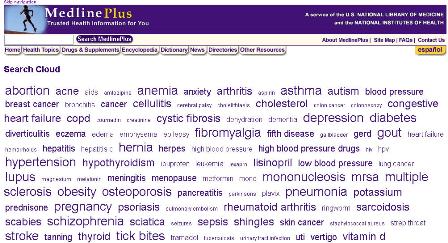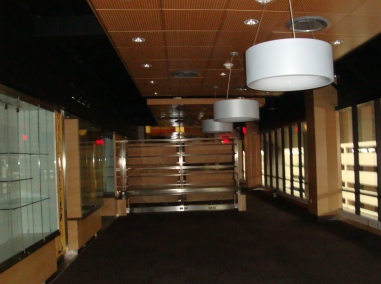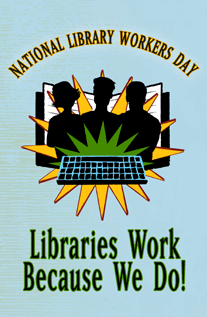Twitter* is all the rage at the moment. From Oprah signing on to Ashton Kutcher & CNN competing for the most followers, but what are the implications for users at a health sciences center?
One of our fellow medical librarians (PF Anderson at the University of Michigan) has a great slidshare presentation on “Twitter in Health & Healthcare” which demonstrates the various uses of twitter for both professionals and patients.
Twitter is even being used as a form of assistive technology for brain injured adults. The University of Wisconsin Biomedical Engineering Department are developing software that allows the use of a “brain-computer interface” which allows the direct input of thoughts into Twitter.
I am HS_Librarian on Twitter.
*Twitter is a microblogging website where users can disseminate information in 140 character posts.

http://www.nlm.nih.gov/medlineplus/cloud.html
It just got a little easier to find out what consumer health topics are currently popular with patients. MedlinePlus, your number one authority from the NIH on patient health, just released a search cloud.
The search terms appear in alphabetical order, and their size represents their relative frequency. The bigger the term, the more often it is searched by people who visit MedlinePlus. A term’s exact ranking is found by placing your cursor over the term, and you can click on any term in the search cloud to conduct a search for that term in MedlinePlus.
Anyone who’s been on a camping trip lately can sympathize with why tick bites are so popular right now.
As part of National Environmental Education Week and Earth Day, the National Library of Medicine is promoting its toxicology resources. These resources include: ToxMAP, ToxTown, ToxMystery, MedlinePlus, Household Products Database, and Hazardous Substances Data Bank (HSDB). Several of these resources are part of TOXNET which provides access a host of information related to toxicology, hazardous chemicals, and environmental health. For more information on Environmental Health and Toxicology, check out the Special Information Services page at NLM.
Here’s a quick sneak peak at the furniture that has been setup for the Library Commons.
Welcome to the first installation of an occasional series called IT CAME FROM THE STACKS: an exploration of the hidden gems in our collection
The Knife Man: Blood, body snatching, and the birth of modern surgery by Wendy Moore (2005)
Available on 4th floor Library Stacks: WZ 100 M78k 2005
This book is about John Hunter, an orphaned Scottish boy who grew up to become 18th century London’s premier maverick surgeon, “as reknowned and respected in Georgian England as he was feared and reviled.” The Knife Man explores this larger than life figure, a master surgeon and anatomist who is not only considered the father of modern surgery, but also an inspiration for literary works from Dr. Doolittle to Frankenstein.
Interesting things I learned from this book:
John Hunter at one point orchestrated a heist of the corpse of the “Irish Giant“, at the time the world’s tallest man, regardless of the Giant’s explicit orders to the contrary. Hunter was so afraid of getting caught that in preparing the specimen, “he hurriedly chopped the Goliath into pieces, threw the chunks into his immense copper vat, and boiled the lot down into a jumble of gigantic bones. After skimming the fat out of the cauldron, Hunter deftly re-assembled the pile of bones to create [his] awesome skeleton.”
In his exploration of sexually transmitted diseases, John Hunter performed a series of experiments on an ‘anonymous subject’ that included inoculating the unnamed man with gonorrhea and recording the effects of various treatments. It is widely postulated the subject of this experiment was Hunter himself. His work Treatise on the Venereal Disease, which stemmed from this research, is available free online.
Though Hunter was a renowned & beloved medical teacher, counting Edward Jenner, who developed the smallpox vaccine, and Dr. Philip Syng Physick, American surgeon, among his many students who carried on Hunter’s zeal for medical education. Hunter’s brother-in-law Edward Home would not hold him in such high regard. After his death, Home stole and burnt many of Hunter’s copious notes, but not before plargiarizing several of Hunter’s unpublished experiments as his own.
Hunter was an avid collector of exotic animals as well as an anatomist skilled in making medical preparations of human bodies. His collection was so large that he built a museum in his Leicester Square home to house the over 13,700 preparations. Hunter’s home was the inspiration for the house in R.L. Stevenson’s The Strange Case of Dr. Jekyll and Mr. Hyde. After Hunter died of heart failure during a meeting with his rivals at St. George’s Hospital in 1793, the collection languished until 1799, when it was bequeathed to the Royal College of Surgeons.
Bottom line: The Knife Man offers a lively, educational and sometimes tragic glimpse into the rise of modern surgery, as told through the life of one of surgery’s greatest masters.
The Library Commons is getting closer to completion. We hear that furniture may be delivered today.

commons carpeted area
Don’t forget the Spring Fling this afternoon; here’s a copy of Chancellor Hollier’s invitation:
I?óÔé¼Ôäód like to personally invite you and your families to our 2009 Spring Fling, our annual team-building event, on April 17th in the 500 block of Bolivar Street. We have been fortunate to receive generous donations from several sponsors to defray the cost of the event. As the end of work schedules and classes varies, the event will be held from 3:30 – 7:30 PM. There will be something for everyone ?óÔé¼ÔÇ£ delicious food and drink, live music from the Boogie Men, an airbrush tattoo artist and clowns with balloons for the little ones. For those of you coming from off campus, free parking will be available in Student Lot 2 (on the corner of Perdido and Bolivar streets). We?óÔé¼Ôäóre grateful to the Campus Federal Credit Union, the Southeast Louisiana Area Health Education Center, and Acadiana Computer Systems for their sponsorship of the event. It promises to be a great time, and I?óÔé¼Ôäóll look forward to seeing you all there!
April is indeed a busy month, adding?é?áAlcohol Awareness Month?é?áto the list?é?áof health observences.
Drinking one glass of wine per day has been clinically proven to provide health benefits. But what are the risks of drinking more than one glass on the weekend?
Brush up on facts about alcohol to help keep you and your loved ones safe.
Also, learn where Louisiana stands in drunk driving statistics.

The ADA Center for Evidence-Based Dentistry has launched a new EBD Web site!
The site is being promoted as a practical resource for scientific evidence. It includes sections on Systematic Reviews, ADA Clinical Recommendations, Resources, and section that allows the user to suggest clinical ideas.
While still growing, this site has the potential to be a significant resource in evidence-based dentistry so check it out and suggest some topics!
 <
<
Along with minority health awareness, library workers, STDs and organ donation, April 2009 is also Occupational Therapy month.
Occupational therapy enables people of all ages live life to its fullest by helping them promote health, prevent?óÔé¼ÔÇØor live better with?óÔé¼ÔÇØinjury, illness, or disability. It is a practice deeply rooted in science and is evidence-based, meaning that the plan designed for each individual is supported by data, experience, and ?óÔé¼?ôbest practices?óÔé¼?Ø that have been developed and proven over time. (AOTA)
The 2009 OT Month theme is autism. The American Occupational Therapy Association provides some useful resources on autism at their site PromoteOT.org
Here at LSUHSC we have an active Department of Occupational Therapy. In 2008 OT students volunteered to rebuild houses in the Broadmoor area. You can find other newsworthy events from LSUHSC OTs on the department news page.
Two classes on library resources will be taught in the dental library in April.
Classes will be held in the Library Conference Room from 12:00 – 1:00 p.m. Please email us or call 941-8158 to reserve your seat in any or all of these classes.
All dental school faculty, students, and staff are invited to attend. Feel free to bring your lunch.
Tuesday, April 21: Health Literacy Julie Schiavo
Learn how health literacy can affect the way you treat your patients. Health literacy is not just the ability to read health information; awareness of your patients?óÔé¼Ôäó literacy level can change how you communicate with them. This class is geared toward anyone involved in patient care.
Wednesday, April 22: RefWorks Liz Strother
RefWorks is a free web-based bibliography and database manager that allows you to create your own personal database by importing references from text files or online databases and other various sources. You can use these references in writing papers and automatically format the paper and the bibliography in seconds.
April is a popular month for health observances, including National Minority Health Awareness Month sponsored by the US Department of Health and Hospitals Office of Minority Health. Preconception is the theme for 2009 with the slogan “Ordinary couples don?óÔé¼Ôäót plan their pregnancies. Be extraordinary!”

National Minority Health Month
Exam Master, a FREE USMLE testbank for LSUHSC students, announces a completely revised USMLE Step 1 Practice Exam. A wise L2 knows, you can never practice enough for this! First time users of ExamMaster will need to create a username and password:
http://www.exammaster2.com/wdsentry/lsuhsc.htm
More information
Today is National Library Worker Day as declared by the ALA-APA (American Library Association-Allied Professional Association). It is a day for library staff, users, administrators and friends groups to recognize the valuable contributions made by all library workers. So come by and give your favorite library worker a pat on the back.

Library Worker Day logo
Originally posted on April 4th, but it turns out I got the date wrong. National Library Worker Day is on April 14th this year.
April is STD awareness month! That?óÔé¼Ôäós Sexually Transmitted Diseases. The CDC estimates that there are approximately 19 million new cases of STDs each year in the United States, almost half of them among young people ages 15 to 24.
Let?óÔé¼Ôäós look at how Louisiana is doing. (Reports from the CDC – STD Surveillance, 2007)
Chlamydia ?óÔé¼ÔÇØ Reported cases and ranked by rates: United States, 2007
1 Mississippi: 21,686 Cases & a rate of 745.1 per 100,000 Population
2 Alaska:
3 South Carolina:
4 Alabama:
5 New Mexico:
6 Georgia:
7 Louisiana: 19,362 Cases & a rate of 451.6 per 100,000 Population
8 Tennessee:
9 Hawaii:
10 Illinois:
Gonorrhea ?óÔé¼ÔÇØ Reported cases and ranked by rates: United States, 2007
1 Mississippi: 8,314 Cases & a rate of 285.7 per 100,000 Population
2 Louisiana: 11,137 Cases & a rate of 259.7 per 100,000 Population
3 South Carolina:
4 Alabama:
5 Georgia:
Primary and secondary syphilis ?óÔé¼ÔÇØ Reported cases and ranked by rates: United States, 2007
1 Louisiana: 533 Cases & a rate of 12.4 per 100,000 Population
2 Alabama: 380 Cases & a rate of 8.3 per 100,000
3 Georgia:
4 Maryland:
5 Tennessee:

 myLSUHSC
myLSUHSC



